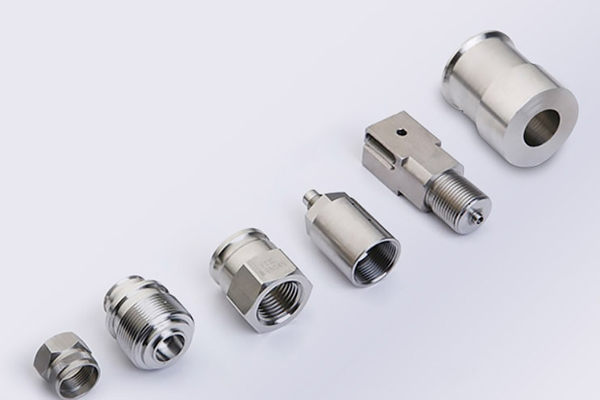Precision Fittings

Precision Fittings
Precise, high-quality fittings are necessary anytime gases or fluids are contained in a system. Installing the right fitting prevents the sort of disastrous leaks that often cause downtime or introduce safety hazards to the work environment. While for any given application, there are likely many viable fitting options, narrowing your search to precision-manufactured components is the only way to guarantee efficient, leak-proof operation.
Precision Fitting Capabilities
Buell Automatics specializes in high-performance fittings designed for maximum durability and efficiency. As experts in precision manufacturing, we produce many fitting types for diverse industrial clients with an emphasis on the following materials and applications:
Brass/Steel/Stainless Steel/Aluminum Fittings
The material selected for fittings is typically selected based on durability, performance, cost, and application. Material selection first must consider what the fitting will come in contact with (water, chemicals, petroleum, air, etc.). If subject to corrosion for example, brass, stainless steel, steel or aluminum may be used with subsequent treatment such as plating, passivation or anodizing. These materials make for the perfect candidate for many fittings. To best serve these diverse clients, we manufacture fittings to varied materials. Some of these fittings are quick disconnect, hydraulic, pneumatic, grease, and plumbing to name a few.
Buell Automatics can support many of the following types of fittings and connectors:
Hydraulic Fittings
Hydraulic fittings form the connections between hoses, pipes, and tubes. These components direct the flow of fluid while also maintaining system pressure and preventing leaks. Depending on the application, materials might include steel, brass, or plastic and often aligns with the material of the system’s conductor. Our precision fittings can accommodate various performance needs, size requirements, and pressure or temperature ratings, being fully customized to each client’s specifications.
Banjo Fittings
Banjo fittings combine a hollow bolt with a spherical fitting to facilitate fluid-transfer. They are most common in brake lines and hoses, but they can be used in other settings that see pressurized fluid transfer. Because of their role in containing hazardous materials, it’s especially important that banjo fittings maintain an airtight seal at all times.
Quick-Connect Fittings
While many fittings are installed once with the intention of remaining in the system long-term, some industrial applications require fittings that can hold up to frequent connections and disconnections. Quick-connect couplings serve this purpose in hydraulic and pneumatic applications. In general, these fittings consist of a simple male-female configuration that can be easily twisted or pulled apart by hand. For quick-connect designs, we balance ease-of-installation with exacting precision standards to ensure that the lines remain fully operational.
Push Fittings
Push fittings, also called push-to-connect fittings, are similar to quick-connect varieties and are also warranted when the system is frequently disconnected. However, rather than requiring two components (male and female), push-to-connect fittings are designed so that tubing can be pushed directly into a hollow fitting.
Vacuum Hose Fittings
Push fittings are commonly seen as the component of choice for vacuum hose applications, so long as the specific fitting has been tested under pressure. Other configurations are possible, but they tend to be permanent and more difficult to install, making push fittings a more convenient option.
Hose Fittings
More broadly, any fitting that connects a hose to another segment of a hydraulic or pneumatic system can be considered a hose fitting. The exact makeup of these components varies drastically with the application: depending on the configuration, hose fittings might be shaped into precise joints or straight connections, fitted exactly to the existing hose. The material must also be compatible with the substance being moved.
Gas or Fuel Line Fittings
Fuel line fittings represent one application where uncompromising precision is vital. Fuel loss is damaging to the operation, the environment, and employee health, so fittings must be carefully engineered to prevent leakage. We offer fuel line fittings to various standard -AN sizes, depending on your desired thread size and application. As a safety precaution, gas fittings are threaded in the opposite direction to most other commercial fittings, preventing accidental connection with lines intended for water or air.
Tube Fittings
Tube fittings resemble hose fittings, and the categories sometimes overlap when a hose is connected to a tube. The difference is that tube fittings are specifically designed to connect rigid spans of tubing to other elements of a system. The shape and material are highly application-dependent, owing partially to the diversity of substances transported in hydraulic and pneumatic systems.
AC Fittings
Air conditioning systems present a relatively volatile environment where pressure and temperature continuously fluctuate. AC units typically contain freon, which poses substantial hazards when released. Due to these factors, AC fittings are designed to be especially resistant to corrosion, pressure, and extreme temperature, all while ensuring an exacting fit with the existing components.
Crimp Fittings
Crimp fittings are designed to fit over tubing before being compressed with crimping pliers or a specialized crimping press. The process of deforming the crimp fitting forms an airtight seal at the end of the length of hose. Because these components must be easily compressible as well as strong and durable, brass is a popular choice, but copper, stainless steel, and poly-alloy fittings are also common.